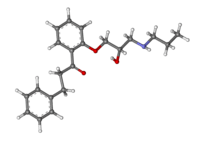Propafenone
Propafenone, sold under the brand name Rythmol among others, is a class 1C anti-arrhythmic medication, which treats illnesses associated with rapid heart beats such as atrial and ventricular arrhythmias.
-Propafenon_Structural_Formula_V1.svg.png) | |
 | |
| Clinical data | |
|---|---|
| Pronunciation | /proʊˈpæfɪnoʊn/ proh-PAF-i-nohn |
| Trade names | Rythmol, Rytmonorm, others |
| AHFS/Drugs.com | Monograph |
| MedlinePlus | a698002 |
| Pregnancy category |
|
| Routes of administration | By mouth |
| ATC code | |
| Legal status | |
| Legal status |
|
| Pharmacokinetic data | |
| Protein binding | 97% |
| Elimination half-life | 2–10 hours |
| Identifiers | |
IUPAC name
| |
| CAS Number | |
| PubChem CID | |
| IUPHAR/BPS | |
| DrugBank | |
| ChemSpider | |
| UNII | |
| KEGG | |
| ChEMBL | |
| CompTox Dashboard (EPA) | |
| ECHA InfoCard | 100.053.578 |
| Chemical and physical data | |
| Formula | C21H27NO3 |
| Molar mass | 341.444 g/mol g·mol−1 |
| 3D model (JSmol) | |
SMILES
| |
InChI
| |
| (verify) | |
Mechanism of action
Propafenone works by slowing the influx of sodium ions into the cardiac muscle cells, causing a decrease in excitability of the cells. Propafenone is more selective for cells with a high rate, but also blocks normal cells more than class Ia or Ib. Propafenone differs from the prototypical class Ic antiarrhythmic in that it has additional activity as a beta-adrenergic blocker which can cause bradycardia and bronchospasm.
Metabolism
Propafenone is metabolized primarily in the liver. Because of its short half-life, it requires dosing two or three times daily to maintain steady blood levels. The long-term safety of propafenone is unknown. Because it is structurally similar to another anti-arrhythmic medicine, flecainide, similar cautions should be exercised in its use. Flecainide and propafenone, like other antiarrhythmic drugs have been shown to increase the occurrence of arrhythmias (5.3% for propafenone, Teva physician prescribing information), primarily in patients with underlying heart disease. However, their use in structurally normal hearts is considered safe.
Side effects
Side effects attributed to propafenone include hypersensitivity reactions, lupus-like syndrome, agranulocytosis, CNS disturbances such as dizziness, lightheadedness, gastrointestinal upset, a metallic taste and bronchospasm. About 20% of patients discontinued the drug due to side effects.
Initiation of therapy
Propafenone generally needs to be started in a hospital setting to assure ECG monitoring of the patient. There are many different dosages of propafenone, depending on clinical presentation of the arrhythmia. The treatment is generally begun with relatively high dosages (450–900 mg/d) decreasing to near 300 mg/d. In most western countries the accepted maximal dosage is 900 mg/d.
For economic and convenience reasons, some clinicians are starting certain antiarrhythmic agents in an outpatient setting for some patients. No consensus exists regarding the safety of this practice, and information is needed to determine which agents and which patients are appropriate for outpatient initiation of antiarrhythmic therapy. From a clinical point of view, this drug is used primarily in patients with relatively preserved myocardial function.[1]
Contraindications and cautions
Caution should be used in administrating propafenone in individuals with hepatic dysfunction, asthma, CHF, or bradycardia.
Stereochemistry
Propafenone contains a stereocenter and consists of two enantiomers. This is a racemate, ie a 1: 1 mixture of ( R ) – and the ( S ) – form:[2]
| Enantiomers of propafenone | |
|---|---|
-Propafenon_Structural_Formula_V1.svg.png) CAS-Nummer: 107381-31-7 |
-Propafenon_Structural_Formula_V1.svg.png) CAS-Nummer: 107381-32-8 |
Patent issues
The patents for the Rythmol family of products are owned by Reliant Pharmaceuticals, Inc., in Liberty Corner, New Jersey. Reliant acquired the patents from developer Abbott Laboratories, Inc., in 2003. Rythmol was originally developed in Europe and marketed by Knoll Pharmaceuticals both in Europe and North America. The product was taken over by Abbott in 2001 when Abbott purchased Knoll.
Reliant Pharmaceuticals filed a federal patent infringement lawsuit against generic drug maker Par Pharmaceutical, on December 19, 2006. The lawsuit, filed in the federal district court for Delaware, seeks to prevent Par from manufacturing a generic version of Rythmol. Par is seeking approval to do so from the U.S. Food and Drug Administration.
Reliant's patent for the drug was issued in October, 1997, and it expired in 2014. Par believes the patent is invalid, according to its filing with the FDA.
See also
- List of cardiac pharmaceutical agents
References
- "Clinical Guidelines and Recommendations". www.ahrq.gov. Retrieved 23 August 2019.
- F. v. Bruchhausen, G. Dannhardt, S. Ebel, A. W. Frahm, E. Hackenthal, U. Holzgrabe (Hrsg.): Hagers Handbuch der Pharmazeutischen Praxis: Band 9: Stoffe P–Z, Springer Verlag, Berlin, Aufl. 5, 2014, S. 387, ISBN 978-3-642-63389-8.
External links
- U.S. National Center for Biotechnology Information: Medical Genetics Summaries - Propafenone Therapy and CYP2D6 Genotype